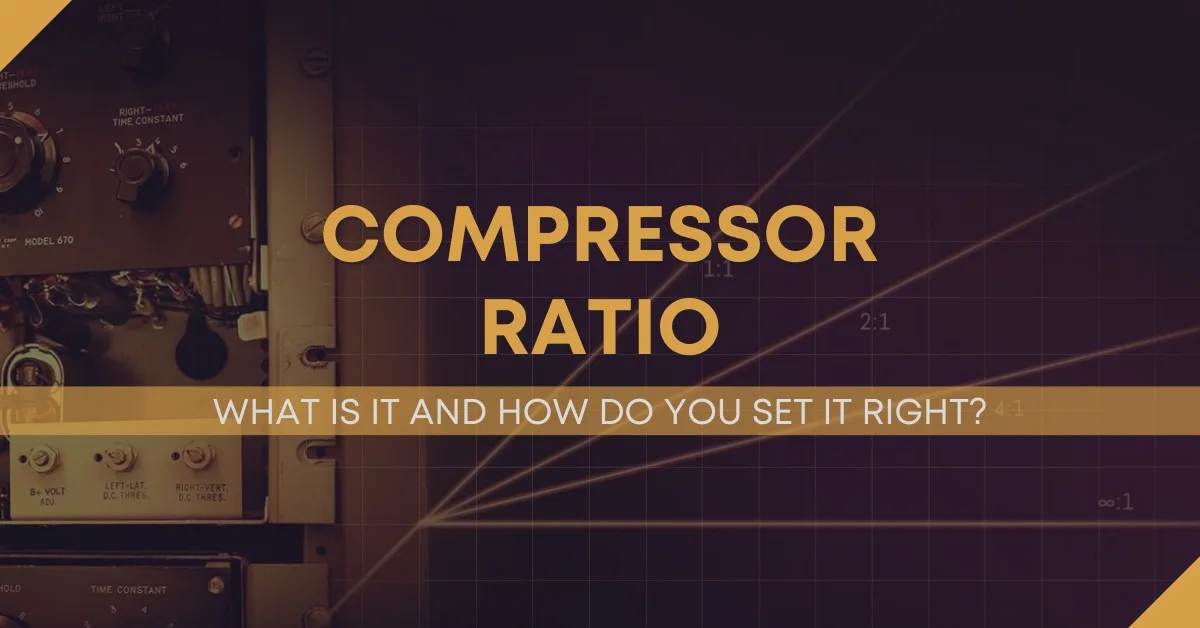
A compressor ratio is just one of a handful of parameters that makes a compressor act, sound, and work the way it does. It's one of the most important settings a compressor has to offer and you need to know how to set it right. If you are not familiar with what a ratio is then don't worry because we are here to help.
In this article, I'm going to discuss what a compressor ratio is, how to set it correctly, and lastly talk about some other settings compressors have in them. After reading this article you are going to be a compressor ratio wizard! So, sit back and lets take a journey into the world of audio compression and ratio.

The ratio of a compressor plays a role in determining how much compression will happen. It goes hand-in-hand with threshold. The first parameter in the ratio is the input level and the second is the output level. If you divide the input signal level by the first number of a compressor ratio, that will give you the output signal level. It's as simple as that!
Example: If you have a ratio of 4:1, then for every 4 decibels of sound that goes over the threshold only 1 decibel will be produced.
The lower you set the ratio the more unaffected the sound will be even at large gain reductions. This is the complete opposite when you set the ratio higher. If you set the ratio to 10:1 or higher, then the compressor will then be known as a limiter.
Related Article: The 4 Steps To Properly Applying Compression On Vocals
Setting a compressor ratio can sometimes seem like a daunting task. Where do you even begin? The truth is that it's a simple process that revolves around either a specific instrument or dynamics. Lets first talk about instrument compression ratios.
Here are my recommendations for instrument compressor ratio settings.
For any lead instrument I recommend a 4:1 ratio. If you aren't sure where to set your ratio then use 4:1 as a starting point. NOTE: I do not recommend compressing rhythm guitars hence why they are not on the list.
If you aren't setting the ratio based on an instrument then the other reason would be dynamics. If you need to control dynamics you will want to use a 4:1 ratio or higher. If you want the performance to be loose but to have some control then a 2:1 or 3:1 ratio is a good choice.
When you compress audio you are reducing the output and you must account for that. Most compressors have a makeup gain option or at the very least an output knob. You will want to use your ears and adjust this upward until it matches the audio level of when the compressor is bypassed. Just because you are get 2dBs of gain reduction doesn't mean a 2dB increase will even it out. Use your ears!
It's important to note that how much you pull the threshold down and how much gain reduction you achieve, plays a large role in how your ratio setting will turn out. But, that is a topic for another discussion!

Compressors can have a range of parameters and settings within them depending on the type, brand, and model. The main settings are threshold, ratio, attack and release. Almost every compressor has these even if you can't set some of them. To learn more about compression, check out my article: Audio Compressor Vs Limiter | Do You Know The Difference?
Learning how to set a compressor ratio correctly is important in improving your audio mixing skills. Compression is probably the most important tool us engineers have when it comes to mixing and it must be applied transparently, tastefully, and artistically. Throughout this article, we have discussed what a compressor ratio is, how to set it, and how important it is. Take this knowledge and let it better you on your journey to audio excellency.
If you found this article helpful, please considering subscribing to my blog for more free tips, tricks, and audio plugin deals. Happy mixing!
"Some of the links within this article are affiliate links. These links are from various companies such as Amazon. This means if you click on any of these links and purchase the item or service, I will receive an affiliate commission. This is at no cost to you and the money gets invested back into Audio Sorcerer LLC."